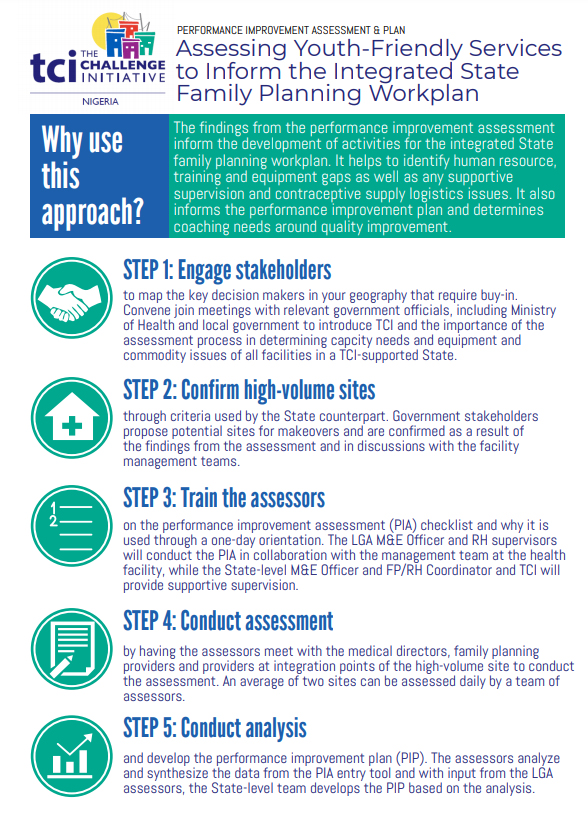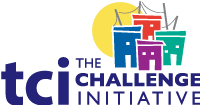Nigeria Toolkit: Services & Supply
- Home
- Help and Support
- Close
- Toolkits
- Global Toolkit
- AYSRH Toolkit
- Hub Toolkits
- Core High-Impact Practices
- Gender Essentials Mini Course
- Close
- Resource Collection
- Community of Practice
- Coaching
- Log In/Register
- My Profile
- English
Performance Improvement Assessment & Plan
What is it?
TCI has adapted NURHI’s Performance Improvement Assessment (PIA) Tool and created an AYSRH module to assess youth-friendly services, which assesses quality indicators set forth by the Federal Ministry of Health’s “National Performance Standards for Family Planning Services for Nigerian Hospitals”. Before the assessment is implemented, the State and LGA M&E Officers provide the State FP/RH Coordinator with data to determine which health facilities are high-volume sites (HVS). Typically, facilities that serve the greatest number of maternal newborn and child health (MNCH) clients in TCI-supported States are categorized as HVS. These sites include both secondary and primary health care facilities and clinics. Once sites are confirmed with TCI M&E Officers, TCI works closely with the State-level M&E Officers and FP/RH Coordinator to ensure that the LGA M&E Officers have the capacity to conduct the assessment of the identified HVS. The findings from the assessment inform the development of a Performance Improvement Plan (PIP), which serves as key inputs into the development of activities for the integrated State FP workplan.
Why it is important?
- Identifies human resource, training and equipment gaps as well as any supportive supervision and contraceptive supply logistics issues
- Informs the development of performance improvement plans for family planning services
- Determining the coaching needs around quality improvement and trainings needs of providers
- Identifying potential facilities for facility makeovers
- Serves as a baseline against which to measure progress
What are the steps for implementing this approach?
Step 1: Engage Stakeholders
Map out the key stakeholders in your geography. Identify the decision makers that require buy-in. Convene joint meetings with all relevant government officials, including Ministry of Health and local government to introduce TCI and the importance of the assessment process in determining capacity needs and equipment and commodity issues of all facilities in a TCI-supported State.
The facility assessment includes structured facility observations and interviews with facility staff. The questionnaire explores hours of operation, personnel information related to health cadre, numbers and type of training received, service statistics, infrastructure, equipment, types and volume of family planning methods provided, contraceptive stocks, record keeping, and other services for integration of FP.
Step 2: Confirm High-Volume Sites (HVS)
TCI verifies criteria used for the identification of the high-volume sites (HVS) by the State counterpart as indicated in the Expression of Interest. At this time, government stakeholders also propose potential sites for makeovers. These are confirmed as a result of the findings from the assessment and in discussions with the facility management teams.
Step 3: Train/Orient the Assessors
Train the LGA M&E Officer and RH supervisors (also referred to as the assessors) along with the State-level M&E Officer and FP/RH Coordinator on the PIA checklist and why it is used. This is a one-day orientation usually on the first day before the assessors go out to the facilities to conduct the assessment. The LGA M&E Officer and RH supervisors will be the ones to conduct the performance improvement assessment (PIA) in collaboration with the management team at the health facility, while the State-level M&E Officer and FP/RH Coordinator and TCI will provide supportive supervision.
Step 4: Conduct Assessment
Before conducting the assessment, the facilities are batched by proximity to each other and LGA RH/FP Coordinators and M&E Officers are then provided transport to go to their respective batch of sites. This way, all HVS are visited for the PIA assessment. The assessors meet with the Medical Directors, family planning providers, and providers at integration points (e.g., labor ward, antenatal clinic, post-natal clinic, post-abortion care units, immunization units, and HIV units) of the HVS to conduct the assessment.
Plan to conduct the assessment for all HVS in two days. On average, TCI-supported States have 30 HVS per State. So, each team of 2 assessors can usually assess 2 sites per day.
Step 5: Conduct Analysis & Develop the Performance Improvement Plan (PIP)
The assessors then analyze and synthesize the data from the Excel template/PIA entry tool. With inputs from the LGA assessors, the State-level team develops the PIP based off of the analysis.
Step 6: Disseminate the Findings of the PIA and Proposed PIP
Disseminate the assessment findings and proposed PIP with all stakeholders through a presentation at an upcoming contraceptive technology update meeting or other planned meetings. TCI has learned that disseminating the findings as part of the workplan development meeting, which it tested in Taraba, is extremely effective in ensuring that the activities identified based on gaps found in the assessment are programmed and supported by multiple stakeholders.
Step 7: Support the Implementation of the Performance Improvement Plan (PIP)
TCI supports the implementation of Performance Improvement Plan (PIP) through a variety of key activities including: training, procurement and distribution of equipment, provision of guidelines, IEC and reference materials, and continuous supervision and mentoring. These activities will be described in greater detail in other approach pages in this program area.
Note: Not all facilities will be renovated (i.e., facility infrastructural upgrade with procurement and distribution of equipment); however, all facilities in a TCI-supported State will receive quality improvement support and facilities where there is a lack of trained FP providers will be slotted to receiving training support.
Step 8: Monitor and Replan
To monitor progress on the implementation of the PIP and associated changes in family planning service utilization and quality, TCI works with State and LGA M&E Officers to collect monthly service statistics on FP and conduct service utilization reviews on a quarterly basis.
TCI APP USERS PLEASE NOTE
You will only receive CERTIFICATES by email – when earning a score above 80% – and will not be able to view or print a certificate PDF from the TCI app.
Test Your Knowledge
Earn a Certificate
Quiz Summary
0 of 5 Questions completed
Questions:
Information
You have already completed the quiz before. Hence you can not start it again.
Quiz is loading…
You must sign in or sign up to start the quiz.
You must first complete the following:
Results
Results
0 of 5 Questions answered correctly
Your time:
Time has elapsed
You have reached 0 of 0 point(s), (0)
Earned Point(s): 0 of 0, (0)
0 Essay(s) Pending (Possible Point(s): 0)
Categories
- Not categorized 0%
- 1
- 2
- 3
- 4
- 5
- Current
- Review
- Answered
- Correct
- Incorrect
-
Question 1 of 5
1. Question
PIAs & PIPs are important because they:
CorrectIncorrect -
Question 2 of 5
2. Question
High volume sites are health facilities that serve the greatest number of maternal, newborn and child health clients.
CorrectIncorrect -
Question 3 of 5
3. Question
For the PIA Assessment the assessors meet with:
CorrectIncorrect -
Question 4 of 5
4. Question
How useful did you find the information and/or tools presented on this page? Please write your response in the box below using one of the following phrases: Very useful, Useful, Somewhat useful, Not useful.
Feel free to comment on why you made that choice.
-
This response will be awarded full points automatically, but it can be reviewed and adjusted after submission.
Grading can be reviewed and adjusted.Grading can be reviewed and adjusted. -
-
Question 5 of 5
5. Question
How do you intend to use the information reviewed and/or tools that you accessed?
-
This response will be awarded full points automatically, but it can be reviewed and adjusted after submission.
Grading can be reviewed and adjusted.Grading can be reviewed and adjusted. -




